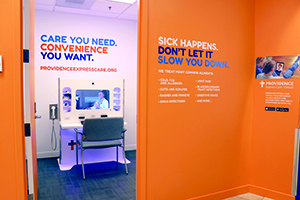Emphasis is on outpatient services, partnerships, population health, new revenue and fiscal discipline
By JULIE MINDAThe U.S. health care system's rapid evolution is compelling providers across the nation to quickly transform their operating model, from one that is hospital-centric and driven by fee-for-service payment to one that is value-based and puts greater emphasis on outpatient services, wellness promotion and disease prevention. Leading providers are at work now to build new streams of revenue to help pay for it all.

Dr. Rod Hochman, president and chief executive of the Renton, Wash.-based Providence St. Joseph Health, says his seven-state system is committed to leading the transformation of health care and sharing its learnings with others about how best to accomplish the change. "We see that as part of our obligation," he says.
The 2018 to 2022 Providence St. Joseph Health Integrated Strategic and Financial Plan maps out the system's transformation. It calls for accelerating the diversification of its operations, developing new ways to engage with patients and communities and building new revenue streams.
The strategic plan is the first for Providence St. Joseph Health. The system formed in mid-2016 through the joining of Providence Health & Services and St. Joseph Health. The merger created one of the nation's largest health systems — it currently has 51 hospitals, more than 800 clinics and 114,000 employees, with most of its operations on the West Coast.
To create the strategic plan and ensure priorities were measurable and aligned across regions, the system gathered input from more than 1,200 board members, executives, physicians, other clinicians and other staff. The system is introducing the plan in meetings with executives; the content will be cascaded down to reach all employees. Providence St. Joseph will be asking all employees to specify how they will carry out the plan.
Health 2.0
Central to the plan is the concept that U.S. health care is evolving from what Providence St. Joseph calls "Health Care 1.0" through "Health Care 1.5" to "Health 2.0." In 1.0 health care services centered around hospitals, and all services were organized to feed hospital referrals. This setup is geographically constrained. The transitional phase — 1.5 — involves a greater emphasis on outpatient care, with the hospital being one of many access points. This system begins to break geographic constraints and introduces digital innovation to extend services to growing numbers of people, according to information from Providence St. Joseph.

Providence St. Joseph says its strategic plan is intended to drive it toward Health 2.0, in which patient and consumer needs and convenience are at the heart of a wide variety of health and wellness services delivered through numerous access points, such as the retail clinics Providence St. Joseph operates at some Walgreens stores. This component of the strategic plan will involve extensive partnering.

Providence St. Joseph says it has ministries in stages 1.0 and 1.5. Annette Walker, president of strategy, says the system's drive to 2.0 is a response to economic forces in health finance. The fee-for-service reimbursements from government payers undergirding health care delivery 1.0 may be insufficient to sustain operations in the future. It is difficult to anticipate changes and innovate under that legacy system, she says. Both the government and private payers are continuing to transition to value-based contracting, where providers share in the risks and rewards based in part on patient outcomes and population health.
Providence St. Joseph says the system also needs to evolve to 2.0 operations to make health care more affordable and manage the rising costs of labor, pharmaceuticals and supplies.
Financial discipline
The strategic plan calls for Providence St. Joseph to invest in employees' development and fulfillment, including by acting upon highly refined employee engagement survey results. Employee formation will be a focus, to equip employees for leading during challenging times, according to information from the system.
Providence St. Joseph says it will aim to achieve top quartile health outcome scores in its facilities, and become the top provider of choice in all of its markets as measured by Press Ganey consumer surveys.
The plan sets a goal to grow the system's operating earnings — before interest, depreciation and amortization — to 10.1 percent of operating revenue from the current 5.7 percent. It says it will do this by improving efficiencies, expanding outpatient capabilities and standardizing care and processes systemwide. Providence St. Joseph also wants to double the amount of philanthropy dollars it secures to $360 million per year.

Mental health
The system is asking its regions to identify their top community needs and then to specify how they will address those priorities. Facilities will supplement information already available in community health needs assessments with additional analysis, particularly of behavioral health needs in their communities. Hochman says unmet mental health needs will be a key area of concentration. He expects youth mental health to be a priority area in many communities. The system's regions are specifying in mental health strategic plans what their areas of focus will be.
Hochman and Walker say in implementing its strategic plan, Providence St. Joseph will leverage the system's long-running work and extensive expertise in population health, housing, education and mental health to achieve its goals around being a wellness partner to communities. Its experts at both the system and facility level in these broad categories will share best practices among Providence St. Joseph regions.
Walker notes that technology will be central to achieving population health improvement. Providence St. Joseph plans to expand the use of apps that help people better manage their health. It has a goal to enroll 1 million users in patient engagement technology. An example of such technology is the Circle app, which enables Providence St. Joseph maternity patients to receive individualized information about their pregnancies, delivery and postpartum care.
The system also plans to offer more digitized health care services. This includes expansion of online scheduling, telehealth interactions and the use of apps to educate patients.
Stretch goals
Providence St. Joseph says its work to transform its future "will stretch us the most and require meaningful changes in our investment policies and partnerships."
Hochman says the system will be diversifying its revenue sources, including by selling products, consulting and other services to other health systems.

Also as part of the effort to transform health care for the future, Providence St. Joseph will intensify its work to offer personalized treatment and wellness services to people, based on their genetic information and individual health information.
Hochman says clinician scientists across the system currently do a significant amount of research, but Providence St. Joseph has yet to connect them with one another in a meaningful way and to get the results of their research to frontline clinicians quickly. To facilitate this, the strategic plan has the system drawing those connections in top practice areas including cardiovascular health, neuroscience, orthopedics and prenatal care.
Hochman and Walker say the strategic plan will advance the way the system delivers care. He notes the system's founding congregations, the Sisters of Providence and the Sisters of St. Joseph of Orange, are enthusiastic about the strategic plan. Hochman says, "The sisters are on board — they are the least afraid of change."
